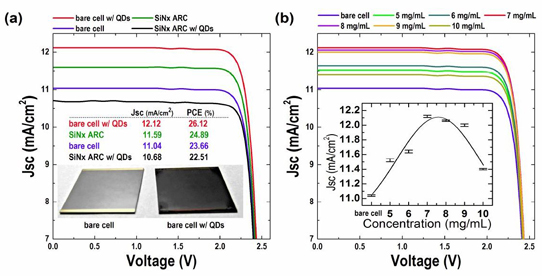- News
4 December 2013
Cadmium selenide quantum dot layer boost for three-junction solar cells
Researchers in Taiwan have used cadmium selenide (CdSe) quantum dots (QDs) to increase the power conversion efficiency of three-junction solar cells by around 10% [Ya-Ju Lee et al, Optics Express, Vol. 21, pA953, 2013]. The team was associated with National Taiwan Normal University, Chang Gung University, and WIN Semiconductors Corp.
The aim of using CdSe QDs was to convert high-energy ultraviolet photons to a wavelength that would boost the performance of current-limiting cells. Multi-junction tandem solar cells are connected in series so that the same current must run through all of them. This limits the performance to that of the poorest sub-cell. Boosting the performance of current-limiting cells to more closely match that of the others should therefore increase conversion efficiency.
The QD bandgap that controls the energy of the converted photons is determined largely by the dot diameter. Photoluminescence experiments suggest that the peak wavelengths are 640nm for 6.6nm-diameter dots and 480nm for 2.1nm-diameter dots.
The gallium arsenide (GaAs) and indium gallium phosphide (InGaP) absorbing layers along with tunnel junctions of the three-junction solar cell (Figure 1) were grown on p-type germanium (p-Ge) substrates using metal-organic chemical vapor deposition (MOCVD). The substrate also acted as a sub-cell/absorbing layer. The top tunnel junction was aluminium gallium arsenide/indium gallium phosphide (p-AlGaAs/n-InGaP) and the bottom one was p-GaAs/n-GaAs.

Figure 1: Schematic of InGaP/GaAs/Ge triple-junction solar cell with CdSe QDs spread on top surface to tailor solar spectrum and enhance photocurrents of current-limiting GaAs middle sub-cell (and InGaP top cells) to more closely match that of the Ge bottom sub-cell.
The CdSe QDs were formed in a sol-gel process. The colloidal CdSe quantum dots in toluene solution were spun onto the top indium aluminium phosphide (InAlP) window layer. After deposition, the toluene was evaporated under a fume hood. The electrodes were silver (Ag). The solar cell chips measured 1cm x 1cm.
The researchers carried out a range of simulations to estimate the optimum QD diameter. A 4.2nm CdSe QD gave a simulated 19% enhancement in power conversion efficiency over a device without QDs. Above 4.2nm diameter, short-circuit current performance of the InGaP-based sub-cell significantly declined in the calculation. The simulations also suggest that without QDs the GaAs sub-cell has the lowest current (9.38mA/cm2) with the InGaP cell just above it (9.60mA/cm2). The Ge sub-cell has a predicted short-circuit current just below 12mA/cm2. Hence, the GaAs and InGaP layers both give current-limiting effects.
Adding the QDs brings the expected currents closer together. The QDs were also expected to have an anti-reflective effect that should be beneficial for all the layers in trapping photons in the structure.
Guided by the simulations, the processed device also used a 4.2nm-diameter QD. The device was compared with tandem solar cells that were completely bare of QDs or that included a 100nm-thick silicon nitride (SiN) layer as an anti-reflective coat. A device that combined QDs on top of a 100nm anti-reflective SiN layer was also processed.

Figure 2: (a) Current density-voltage (J-V) performance of tandem solar cells with and without 4.2nm-diameter CdSe QDs and silicon nitride anti-reflection coats under AM1.5G sunlight illumination (100mW/cm2, 1-sun). The QDs came from a solution with optimum concentration of 7mg/mL for the spin-on process. Inset: photograph of actual 1cm x 1cm devices. (b) Characteristics with varied concentration of CdSe QD spin-on solution. Inset: summary of short-circuit current density (0V) as function of QD concentration.
The performance of such devices (Figure 2a) showed that a cell with only QDs performed best with a power conversion efficiency of 26%. The worst performer was the device with both QDs and anti-reflective SiN. The open-circuit voltage of the devices was 2.51V. The fill factors were in the range 85.4-85.9%.
The effect of using different QD solution concentrations in the spin-coating process was also tested (Figure 2b). The optimum concentration was 7mg/mL. Reflectance measurements found that this concentration also gave the minimum reflection of the incoming radiation. This is attributed to refractive index matching between the QD layer and top InGaP sub-cell that directs converted photons into the device.
CdSe CdSe quantum dot Three-junction solar cells p-Ge substrates MOCVD
www.opticsinfobase.org/oe/abstract.cfm
The author Mike Cooke is a freelance technology journalist who has worked in the semiconductor and advanced technology sectors since 1997.


